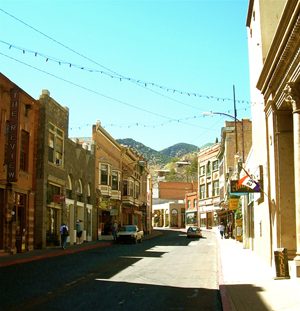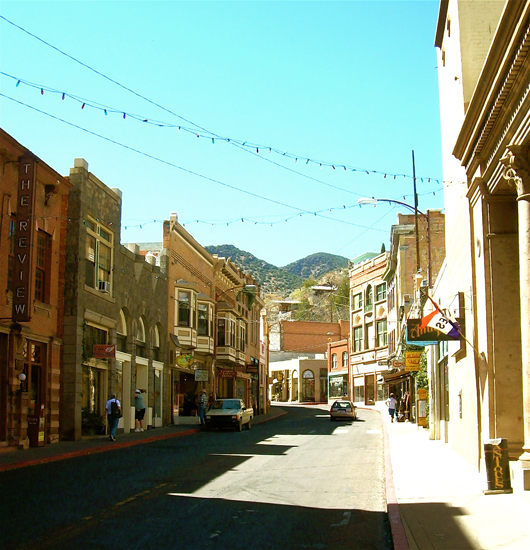
It retained its rough edges, however, and celebrated statehood in true mining-camp style—setting off 48 sticks of dynamite in a mining hole near its downtown.
Next year’s centennial festivities will mimic that raucous salute—with a decrease in firepower necessitated by Homeland Security concerns.
Copper mining ceased in Bisbee more than 30 years ago, but it remains the best place to envision what life was like in an Arizona mining town 100 years ago.
Its handsome Main Street, lined with substantial brick buildings, looks much the same as it did then.
That streetscape was new when its residents celebrated statehood. Disastrous fires in 1907 and 1908 had leveled the wooden buildings in Tombstone Canyon.
The wealth of the city’s mining and merchant class made rebuilding a snap. Merchants set up shop amid the ashes, and most buildings were rebuilt within a year, using stone and brick this time.
Bisbee was officially Arizona’s third-largest city when President William H. Taft signed the statehood proclamation, with a population in the 1910 census of 9,019.
That figure, though, failed to include the residents who lived outside of what is now called “Old Bisbee,” including those who lived in Warren, Arizona’s first planned community, where stately mansions lined five-block-long Vista Park.
Bisbee historian Gary Dillard said the city’s population was closer to 20,000, which would rank it ahead of Tucson and Phoenix at the time.
It was a substantial place. It boasted the state’s only golf course, baseball stadium and stock exchange. It had three theaters, all making a transition from vaudeville shows to motion pictures.
An electric streetcar ran the length of Tombstone Canyon, headed south to Warren, and then beyond to the golf course, tennis courts and shooting range of the Bisbee Country Club.
Bisbee’s mining wealth attracted rail lines and had just created the nearby border city of Douglas—sited as a convenient spot to smelt copper from mines in Bisbee and Mexico.
Relocation of the smelter provided relief to Bisbee’s smoke-choked canyons. The air grew cleaner as the town grew richer.
The Bank of Bisbee, “the largest in Southern Arizona,” advertised an astounding $1 million in assets in the Bisbee Daily Review—$22.8 million in today’s dollars.
Today, Bisbee’s population has shrunk to 5,575.
It remains the Cochise County seat—an honor it stole in 1929 from nearby Tombstone, whose population dwindled after its silver mines flooded in 1887.
Bisbee, which built its fortune on copper, was prosperous for a longer haul.
It didn’t start out as a copper-mining town, said Dillard, native son, journalist and longtime student of Bisbee’s history.
“Everyone was looking for gold and silver,” Dillard said.
The ore discovery made by Army scout Jack Dunn in 1877 and followed up by George Warren was actually cerrusite, said Dillard, a compound of lead often found in association with silver.
Copper was also present, but until Thomas Edison began building power plants in the late 19th century, it was not a coveted ore.
Bisbee lucked out, said Dillard. Its copper ore body was rich and its mining infrastructure was in place when the electrification of America created a demand for copper wire that all the mines on Earth couldn’t fill.
The oxides in the first 300 to 500 feet of the upthrust Mule Mountains were up to 40 percent pure copper. “You’re talking about materials that today would be collected as specimens,” Dillard said.
In 1911, Bisbee mined 133 million pounds of copper, almost half of Arizona’s total. In the coming decade, it would ramp up production as World War I created even greater demand.
By 1912, Bisbee had been transformed from a hardscrabble mining camp to a sophisticated city where women bought the newest fashions from merchants named Levy and Goldwater, among others.
Italianate villas and Victorian mansions were built.
“It had a huge merchant class,” said Dillard. Many residents were partial owners of the mining enterprises, trading their shares on the stock exchange, now a tourist bar at the mouth of Brewery Gulch.
A hotel, built by the Copper Queen Mining Co., advertised itself as “the Copper Queen Hotel and high-class cafe.”
It was an important place. “Industries like copper were driving the American Industrial Revolution,” said Carrie Gustavson, director of the Bisbee Mining and Mineral Museum.
Bisbee was Arizona’s first urban outpost, she said—“a Western version of an American industrial city.”
By 1917, it had reached a population of about 22,800, said Boyd Nicholl, Bisbee photographer, tour operator and city councilman for the historic center of town.
1917 was also the year of Bisbee’s most notorious episode—the forced deportation of 1,300 miners who were organizers or sympathizers of the Industrial Workers of the World, a labor outfit considered seditious by the mining interests consolidated under the Phelps-Dodge Copper Co.
The mining bosses controlled the newspapers and the authorities, and they hatched a scheme under which Sheriff Harry Wheeler, his deputies and an army of armed volunteers rounded up the union men and put them in boxcars. They were shipped to the desert near Columbus, N.M., with orders not to return.
Over the decades, Bisbee’s fortunes rose and fell with the price of copper.
As the richer veins played out, Phelps-Dodge turned to open-pit operations as early as 1917. A major expansion came in 1950, as P-D moved homes and highways and leveled hills to create the Lavender Pit – 900 feet in depth and 300 acres in breadth.
Those activities subsided by the early 1970s. The last underground mine closed in 1974 and the pit in 1975.
Bisbee had produced 8 billion pounds of copper in its day, but its day was over.
Property values plummeted as population dwindled. Miners moved on and hippies moved in, attracted by Bisbee’s low cost of living and its charm.
Entrepreneurs came as well, buying up properties that had potential for creating a tourism-based economy. The Copper Queen Mine became a mine tour. The Copper Queen Hotel was refurbished. Old mansions and schoolhouses became bed and breakfast inns.
Bisbee’s mining past became its future.
The entire city is on exhibit, Gustavson said. “Because the historical landscape is so well preserved, you can walk around Bisbee and feel it.”
Beyond the townscape that copper built is the pit where it was mined and the housing developments it spawned, including Warren, whose mansions are now dwarfed by low mountains of broken rock—the tailings from the pit.
Bisbee continues to shrink. It lost 900 residents between 2000 and 2010, but Dillard thinks the numbers are deceptive. It has become a place where folks from Tucson and Phoenix have second homes, attracted by its mild, mile-high climate and its picturesque setting in the Mule Mountains.
It is not just a tourist town, though shops, restaurants, hotels, B&Bs, galleries and antique sellers abound.
Its economy is fueled first by government jobs. In addition to being the county seat, it is also a convenient bedroom community for government employees of the Douglas prison, the community college, Univeristy of Arizona South in Sierra Vista, the Border Patrol and Fort Huachuca.
“A caravan leaves every morning for Fort Huachuca. I did that myself,” Nicholl said.
Bisbee is also home to self-employed telecommuters and artists, and a growing number of retirees.
Dillard thinks Bisbee’s copper days are far from over. There is plenty of ore left beneath the ground. “Look at the market worldwide. There is just huge demand,” he said.
Freeport McMoRan Copper & Gold, Phelps-Dodge’s successor in ownership of Bisbee’s mineral wealth, has not announced plans to resume mining, but Dillard expects it will one of these years.
In the meantime, Bisbee remains a copper town.
___
Information from: Arizona Daily Star, http://www.azstarnet.com
Copyright 2011 Associated Press. All rights reserved. This material may not be published, broadcast, rewritten, or redistributed.
AP-WF-07-14-11 0807GMT
ADDITIONAL IMAGE OF NOTE


